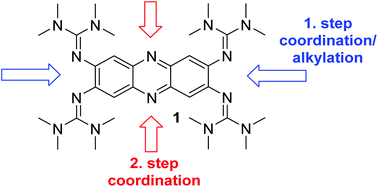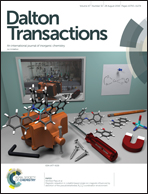Di- and tetranuclear transition metal complexes of a tetrakisguanidino-substituted phenazine dye by stepwise coordination†
Abstract
2,3-Bis- and 2,3,7,8-tetrakisguanidino-substituted phenazines are intensely-coloured dyes that offer two different sites for metal coordination or benzylation, namely the imino nitrogen atoms of the guanidino groups and the phenazine nitrogen atoms. In this work, sequential coordination at both sites is studied, and the effects on the electronic structure and optical properties are analyzed. The step-wise coordination is used to synthesize tetranuclear mixed-valence (CuI)2(CuII)2 and heterobimetallic Cu2Ni2 complexes. Coordination at the guanidino groups switches on a ligand–metal charge-transfer character of electronic transitions in the visible region, leading to a massive intensity gain in the case of copper coordination. The second coordination step with CuI takes place at the phenazine nitrogen atoms and further decreases the ligand frontier orbitals. In the case of two tricoordinated CuI atoms in the product complex, the charge-transfer character of the electronic excitation vanishes, while their energies are very similar. On the other hand, for CuI atoms with a coordination number of only 2, the stronger Cu–N bond leads to a red-shift of the electronic transitions.



 Please wait while we load your content...
Please wait while we load your content...